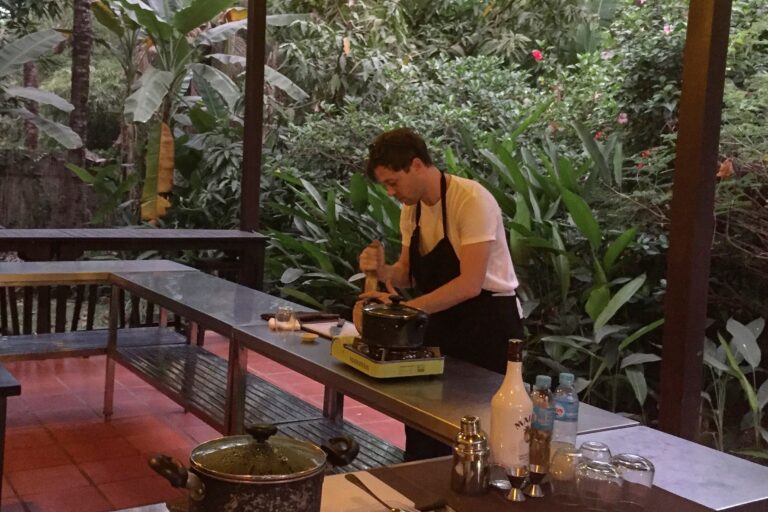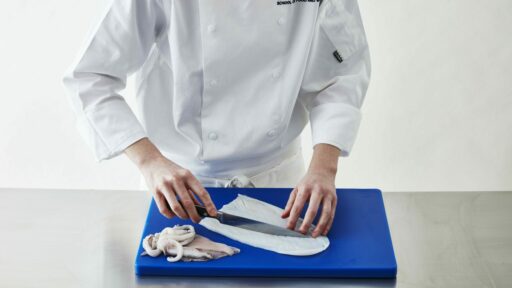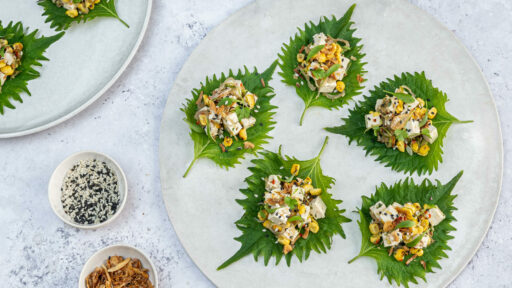After winning Best Pitch on our How to Start Up a Successful Business course, Tom Geoffrey went on to become the chef and founder of Barang Street Kitchen, a Cambodian street food concept and pop-up. Tom tells us about his love for Cambodian food, his plans for Barang, and how attending Leiths’ food business course helped him achieve his dreams.
How did you get into Cambodian cuisine?
“I was one of those kids who would eat most things. My mum introduced me to a great little independent Thai restaurant in Bristol where I’m from and I became addicted to Southeast Asian food ever since. In 2017, I went travelling to Cambodia, Vietnam and Thailand. I spent ten days in Cambodia on that tip and fell in love with the people, culture and food. I remember watching the street hawkers in Siem Reap and Phnom Penh, observing their techniques, and it was at this point that I knew I wanted to explore Cambodian food even more, my thoughts now racing on how I could use that inspirating in creating a Cambodian food business back in London.”
You did the How To Start Up A Successful Food Business with Chris Barber at Leiths. How was your experience?
“It was always in the back of my mind to create my own business. I worked as a chef for about four years in kitchens around East London. I only started cooking professionally when I was 30 but it just felt so ‘right’. Unfortunately, the hours and pay at that time in my life just wasn’t sustainable. I changed direction back in 2016 and have been working in events at a university since, but my goal has always been to return to professional kitchens, preferably with a business and concept of my own.
“When I came back from Cambodia, I thought ‘this is the one’, so I did the How To Start Up A Successful Food Business course at Leiths, which showed me that running your own business isn’t all about the cooking. There’s the operational side, back of house, GP, creating your brand. I won ‘Best Pitch’ which really inspired me to plough ahead. Chris said, ‘you’ve really got something here’. I stayed in touch with Chris and we speak quite a lot. He has a wealth of industry knowledge and has been really helpful.”
How did you develop the concept?
“I returned to Cambodia the following year to do a ‘food reconnaissance’. It was the street kitchens which really inspired me and got me excited. I was especially interested in barbecue. That’s always been a real passion of mine. On every street corner, someone was cooking over fire, coals burning at 6am in the morning! I absolutely love that. Since day one of creating Barang, BBQ has featured heavily through many of the dishes that I’ve put together, including the use of barbecue smoking techniques on meat utilising Cambodian ingredients, particularly Kampot pepper. I’m not going to pretend I’m not massively inspired by restaurants like Kiln and Smoking Goat, especially how they combine authentic ingredients with amazing British produce cooked over fire.
One thing I’ve always said from the start, I’m not claiming to do authentic Cambodian food. There are some recipes out there which I’ve used for inspiration; these recipes belong to Cambodia, to the people of Cambodia, they are recipes handed down from generation to generation. I’m cooking food from another culture and another people; you must be considerate of that; you have to do your research. I didn’t want to rush into it, when I’m not Cambodian and I’ve got no connection other than being a visitor there.”
For those who aren’t familiar with it, can you tell us what to expect of Cambodian food?
“The first question I’m asked is always ‘what’s Cambodian food? What does it taste like?’ In a nutshell, the flavours (and many dishes) are similar to those found in regions of Thailand and Vietnam. Aromatic herbs and spices are a huge part of Cambodian cuisine. The heartbeat of Cambodian cuisine is the curry paste called kroeung which is very aromatic with lemongrass, galangal & makrut lime leaves. Cambodian curry pastes are usually milder than their Thai counterparts. Prahok (fermented fish paste) is also used heavily through many dishes as a seasoning or condiment. Jasmine rice of course is an absolute staple part of a Cambodian’s diet, and most meals will feature it. I absolutely love the Pork & Rice breakfast dish (Bai Sach Chrouk), thin pork strips marinated in coconut milk then cooked over coals and served with rice, pickled veg and often a fried egg.
“The Khmer Empire was huge, and covered much of what today is Cambodia, Thailand, Laos, and southern Vietnam. Khmer cuisine is the more traditional. Cambodian cuisine has incorporated many different elements from Indian, Chinese, and French influences. You’ve also got regional differences. On my pop-up menu is Saraman curry, which is a cousin of the Thai massaman curry or the Indonesian rendang. It’s a rich curry, warming with many spices, traditionally done with beef and hails from the Cambodian Cham Muslim people. I’ll be using beef chuck and doing a vegan version using pumpkin. One of the ingredients Cambodia is most famous for is Kampot pepper, which has many different varieties from black, red, white, and green. I don’t think there’s a better peppercorn in the world. My crispy fried chicken and cauliflower both use the black variety in the flour before they’re deep-fried. I also use it for the roasted pork belly dish with a green herb and chilli dipping sauce.”
What plans do you have for Barang Street Kitchen?
The next step after the pop-up is to find a pub kitchen to take over full time, to leave my job and dive in headfirst. It needs to be right. I’ve been using Instagram (@barangstreetkitchen) to network, and build up a bit of buzz, and get people looking at my plates and wanting to eat them.
Book our How to Succeed in a Food and Drink Business class here.
Interested?
Explore more of our Professional Courses:




